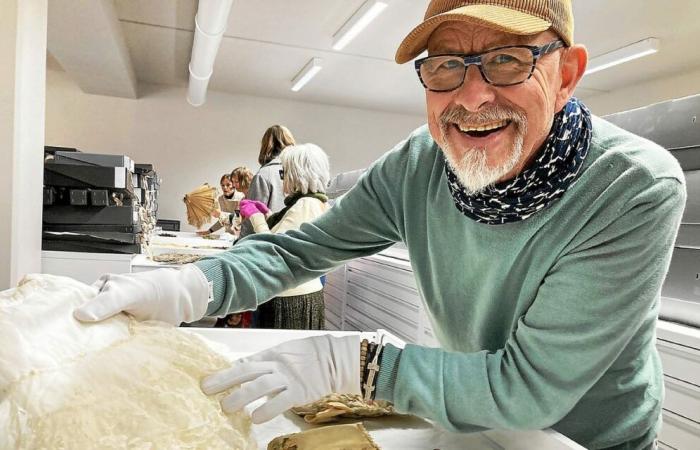
Among the basket dresses of the 18th century, veritable cathedrals of silk, this man’s suit would almost pale in comparison. And yet. “It’s moving,” confides Bertrand Le Pen, lifting the lapel of the beige silk jacket to examine the embroidered button. When I go to the museum, I can only look. This is the first time I’ve touched an 18th century costume. Just the detail of a gathering thread is wonderful.” A tailor and fashion designer who loves historical costumes, he specially came down from Pontivy, with thirteen other members of his association, Crinolines et Cie, to study the collection of 300 costumes and accessories from the Departmental Archives in Vannes.
From the pre-Revolution dress to the Charleston dress
We owe this historical treasure to the collector Monique Bouquet-Nadaud, a costume designer recognized in the world of cinema, who exhibited these costumes to the public in her Château de Crévy, in La Chapelle-Caro, near Ploërmel. When he died in 2002, the Department acquired half of the collection: around sixty dresses, a few men’s suits and a number of accessories. “This collection, quite complete, illustrates fashion from the mid-18th century to the early 1930s, from the pre-Revolution dress to the Charleston dress,” explains Camille Robillard, in charge of conservation and promotion at the Department since 2022. For the visit enthusiasts of Crinolines et Cie, she put five costumes on mannequins, most of them from the 18th century, and in deep drawers, a sample of accessories: fans in ostrich feathers and tortoise shells from the beginning of the 20th century, engageantes (detachable sleeves) from the 19th century, or even men’s vests in embroidered silk.
“People were in it”
Since 2022, Camille Robillard has been pulling these pieces out of their sleep to immortalize them. “We would like everyone to see them, but we cannot expose them to the light for more than three months every three years because the color of the fabrics fades quickly, we see it on certain dresses exposed for too long at the Château de Crévy” . She works with Olivier Hameury, who has the rare privilege of photographing the collection. “The people were inside, it’s human, very intimate,” he says. Failing to display them in a window, “we are going to put the photos of the 300 costumes and accessories on the Archives site in 2025,” announces Camille Robillard. A mission that takes many months, because to take his portrait, each costume must be installed on a mannequin and accessorized. A whole science, which requires both historical and very fine sewing knowledge.
Camille Robillard sometimes calls on the history buffs at Crinolines et Cie. She opens a box. A romantic style cotton canvas dress appears. Immediately, one of the seamstresses guesses the date – around 1835, and provides advice for putting it on a mannequin. “Worn with padded petticoats, no crinoline, no structure,” notes Camille Robillard. “We have a few period pieces at the association, but we have never seen so many costumes in an exceptional state of conservation,” exclaims the president of the association, Pauline Deschatrettes, as she leaves. For us, it’s a treasure chest.”





